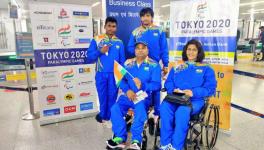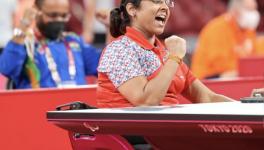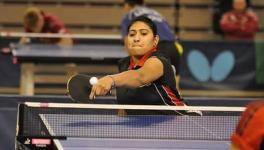Lofty Ambitions, Faulty Grassroots: India’s Para Athletes Caught in the Vortex of Inefficiency

Devendra Jhajharia, who won gold in Rio 2016, attributes his success to the ‘junoon’ he never let die, and admits that massive problems exist at the district and state level for para sport in India.
In a normal year, without a raging pandemic dictating normalcy [or the lack of it], India would have been welcoming back the Paralympic contingent from Tokyo around this time. The 2020 Paralympics, as per the original schedule, was slated to conclude at the Japanese capital on September 6. After the good show in the previous edition in Rio (four medals including two gold), India were understandably confident of bagging a few more this time. That will have to wait for a year.
The Paralympic Committee of India (PCI) — the body which oversees the running of para sports in the country — is confident, or rather hopeful, that the postponement and the break in training due to the lockdowns won’t affect the chances of India’s elite para athletes. ‘Elite’ being the key operative here for it seems the para sports programme in the country exists only for the showpiece events. The programme is shallow beyond our wildest reckoning, and, going by the state of affairs at the grassroots, and even at the state and national levels, it is a surprise indeed that India returned with four medals from Rio last time.
Also Read | Para Sports in India: Sidelined Despite the Spotlight
How haphazard the system is, and how discriminative it can be to the very athletes it is supposed to support, is best illustrated by an incident narrated to Newsclick by one of the officials on condition of anonymity.
“There is this girl in Amravati, Maharashtra, A para-athlete who didn’t have hands [palm] from wrist onwards. She won three medals at the state level in athletics,” said an official. “When she was going for the national trials, she was told ‘you’re not eligible’. She was told you’re aren’t disabled enough, and your hands need to be cut a little more in order for you to be considered as disabled… This was conveyed to her by the state secretary.”
Let those words sink in, let the harshness of it shake the conscience, before we delve deeper into how things are in Indian para sports.
The whole Paralympic establishment hinges around those athletes who have made it to the top rung in the country and who have the potential to win at the grand stage. In fact, rotating this small, no doubt talented, pool of athletes for various events is standard practice. And the PCI officials are quick to point out the expectations from them.
Gursharan Singh, president of the PCI, said he is expecting at least 15 medals when the Games are staged in Tokyo next year. An unprecedented number. The expectations are set high, but with no sign of camps or plans to restart the training of these athletes who are left in a limbo by the Covid-19-forced lockdowns.
Rakesh Gupta, chairperson of athletics in the PCI, echoed Gursharan’s views, though with a tinge of realism, almost as a disclaimer.
“We are expecting 15 medals, but the reality is that the kids are out of training for the last six months. Self-practice is there but there is always a limitation to that. Even then we are expecting 12-15 medals in all para sports.”
There is, of course, no problem in hoping for medals from the athletes and expressing confidence in their abilities. That would, in itself, act as a motivating factor for them to push further. However, speaking to the athletes, it also became clear that the PCI, or affiliated state bodies, have done very little at the grassroots to get these athletes up to the level that they are at the moment. Most have climbed up from obscurity, dealing with the challenges, on their own, using their own resources, and the support of their immediate family, friends and even NGOs. Their success is in spite of the system, but it is the system which gets highlighted when they land success abroad.
A look beyond the glitter of the medals would show the reality, though. There seems to be no system down there. It is difficult to find a point from where one can begin painting the bleak picture.
It starts right when these athletes, as kids, aspire to break the shackles that their disabilities have thrust upon them, and make a mark in sport. At that early stage, there are no set frameworks in place for the athletes to begin. This includes the most basic of things — a place to train and someone to guide.
The arduous path seems to be the same for all para athletes from that point. Most train at home, and then compete directly at the state level. Most states don’t have a district level body or competitions. Apparently, proposals were made to the respective ministries over the years, but there have been no constructive steps taken towards setting up an organisational structure for para sports in the country starting from the districts. Now, we all know the role district level competitions and framework play in promotion of sport at the grassroots. Indian para sports do not have that basic foundation to start with. The rest, well, you can imagine.
Shweta Sharma, a mother of two, has been bound to a wheelchair right from childhood due to polio. She narrated the challenges faced while beginning her journey in shot put and javelin throw: From accessibility issues at sporting facilities which don’t have ramps and the basic infrastructure for wheelchairs, to lack of specialised coaching.
“For me, difficulties started even before I reached the stadium. Since I am a wheelchair athlete, reaching gyms was a tough task. I resorted to training at empty plots, parking lots or just parks in my locality. When I started competing in 2016, I started playing on local grounds. There were times when people at the parks helped me train,” Shweta, 34, who has won many medals at international meets subsequently, said.
Also Read | Gold Medal, Cold Reality: The Famed, Forsaken & Forlorn Heroes of Indian Football
The journey of a para athlete is fraught with problems. There seems to be no end to it and after one challenge is overcome, another surfaces in the very next step. The lack of access to proper training facilities is a constant and common narrative across disciplines. That struggle continues till an athlete reaches a certain stature — till he or she lands a Paralympics, world or Asian level medal. That’s when the authorities take note and step in with support.
Devendra Jhajharia, javelin gold medallist from Rio Paralympics, has reached that stage. When he looks back now, he can only attribute his success to the fact that there was a drive within him that never died. The “Junoon”, he said, to play for the country was that large.
Most para athletes have that kinda drive, while the adversity they live with, gives them steely resolve. Indian para sports seem to be driven by this unfathomable inner drive more than any system put in place.
After being encouraged to go out and play by his mother, the then 16-year-old Jhajaria became fascinated with how the javelin zipped through the air once released. He soon took to the sport. This was in 1997. “I went to the district level and became the champion and it was no lesser than winning an Olympics medal for me,” said the 39-year-old, who won gold in the F42 javelin event in Rio.
Problems Remain Uniform
“At the university level, my javelin throw record was 61 meters, and I defeated a boy who had taken part in international meets, and was able-bodied. RD Singh was one of my coaches, and in 2002, I was a part of the Para Asian Games. My father came with me to the camp and I was trying the blazer again and again and my father asked me what the problem was… I said I was just fascinated with the idea of wearing the India blazer. I threw the javelin at that event to 57.1 meters and won gold.”
Jhajharia had arrived. He broke many international records since 2002 and currently holds the Paralympics record for javelin throw (F42), at 63.97 metres.
Also Read | PUBGM Ban Set to Dent Growth Rate of eSports in India
“There was a time in Athens (2004 Paralympics) when I used to wear Rs 300 shoes. I used to train with random things I could get my hands on… But now, every athlete gets equipment and the government has done a lot.
“The only problem that I do see is at the state level, where there should be many para friendly stadiums, there are not many. The state doesn’t really have a lot of para-friendly infrastructure. They are making them but the pace is slow,” the athlete from Rajasthan said.
Though Jhajharia said there is better support now, compared to when he started, the reality is still not rosy. Shweta narrated her struggle for support while preparing for an Asian meet in 2017. This was a year after Rio, the Games celebrated as the one which heralded the coming of age of Indian para sports.
“I faced a lot of financial difficulties when I decided to become an athlete. Since I am a single mother, I was going through a lot. I didn’t know the proper guidelines. Without support, training was very tough,” the athlete from Delhi, who won a bronze medal in javelin (F54 category) at the 2017 Asian Para Grand Prix in China, said. Getting to that meet in China was an arduous task in itself.
“There were a lot of problems when I was going to China in 2017. I didn’t know I had to go on my own personal expense. I had to pay around Rs 1 lakh for my flight and stay. That was tough. I had to ask for sponsorship from NGOs, or sponsors,” she said. “That time, even because the time was so tight, I couldn't ask for help from the government. I went through a lot of trouble. I got help from Wheeling Happiness.”
Also Read | US Open 2020: Serena Williams Beats Sakkari To Enter Final Eight, Rohan Bopanna-Denis Shapovalov Bow Out
It was only after the 2018 Asian Para Games that she started getting proper government support for her training and nutrition.
Another international athlete revealed how things are so bad that the athletes need friendly contacts in the association to get basic things done. He did not have those contacts and from there began his list of troubles. Things, however, changed for the better as he got acquainted with the system and realised means on how to get the work done.
“I didn’t know a lot of people in the association… secretary, president or vice-chairman… I didn't know most of them. I had to go through a lot of trouble to get even a small thing done,” the athlete revealed.
“When I had to go for international tournaments, my financial condition wasn’t this sound that I could bear all the expenses. But all that changed when I won a few international medals. That is when I got support from the government, sponsors and I even got a few scholarships.”
‘State’ of Affairs
PCI officials don’t deny the lack of competition or structure at the grassroots for para athletes. However, the officials, even while admitting shortcomings, indulge in the great Indian passing of the puck routine too, blaming the state governments for their own problems.
“Sports and education are state matters, and every state has its own priorities and guidelines. Everything matters on state priority since the budget gets allocated after that,” said Rakesh Gupta of the PCI.
“We talk about an inclusive society but there is a lack of initiative on all levels, be it university or at district but I want to change that,” he added. Giving an example of the capital city he says, “There are no identified districts in Delhi as of now, but government demarcated districts are there. There is no district association. There are no state coaches in Delhi as such, the kids practice at their own level. State-level doesn’t have a system per se.”
Gupta revealed that a Rs 16 crore project has been submitted to the Union Sports Ministry with the focus to get para sports to the forefront by expanding its base.
“There is a huge gap in the state when it comes to showing policy and then implementing it. They have a decorative policy to show that they are inclusive but the majority of the athletes say they are not getting any benefits of it. There is no use of any such policy. The state government knows that if they don’t work for top para athletes, they will get exposed. However, kids call and say they expected to get something from the policy but have not got a lot. Policy-program and implementation are largely two things when it comes to state para-sports,” he concluded.
Gupta’s words shed light on a state vs centre differential as far as implementing policy for para sports is concerned. However, isn’t it the job of the PCI to act as a bridge between “state” and “central” matters for the benefit of the athletes? The intent was highlighted by the officials while in conversation but things largely remain on paper.
Bridging the gap between policy and implementation happens to be the primary justification for the existence of the PCI. That process would probably be a starting point for establishing a proper framework for para sports in the country, besides reaching out to possible stakeholders at the grassroots for setting up of programmes.
As things stand, nothing is in place, and with the pandemic, the situation seems to have worsened, both for the established athletes as well as the kids aspiring to break out. There is light at the end of the tunnel though. The 15 medals, but of course!
Get the latest reports & analysis with people's perspective on Protests, movements & deep analytical videos, discussions of the current affairs in your Telegram app. Subscribe to NewsClick's Telegram channel & get Real-Time updates on stories, as they get published on our website.
























